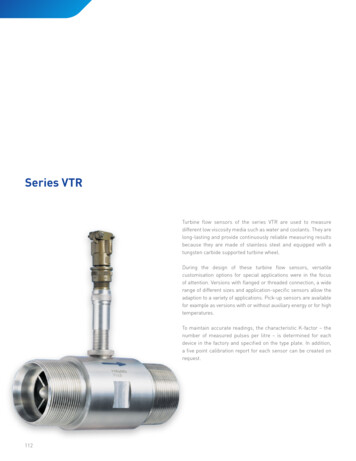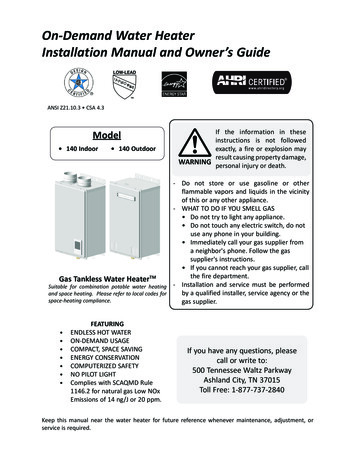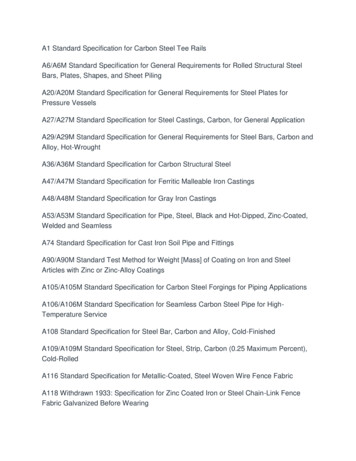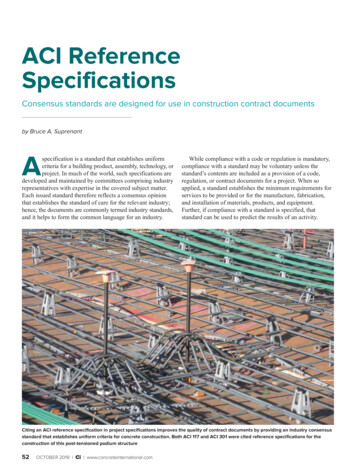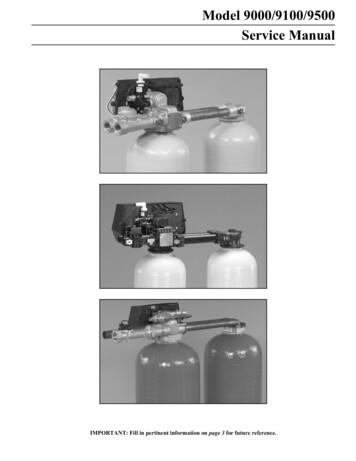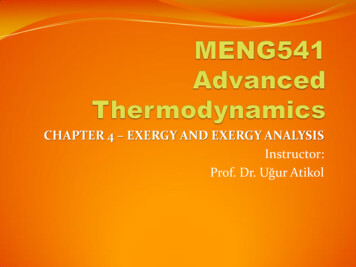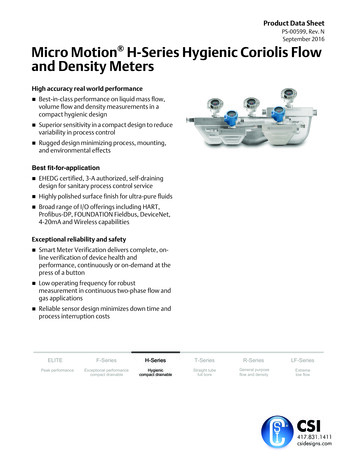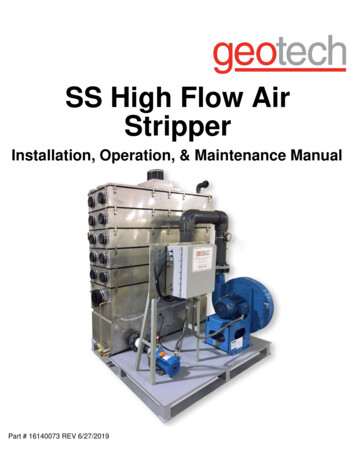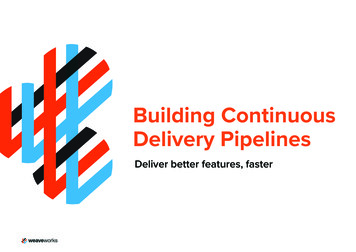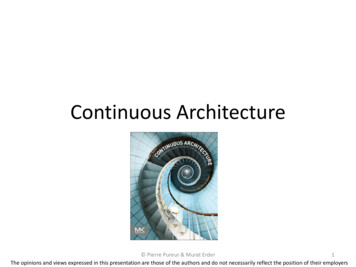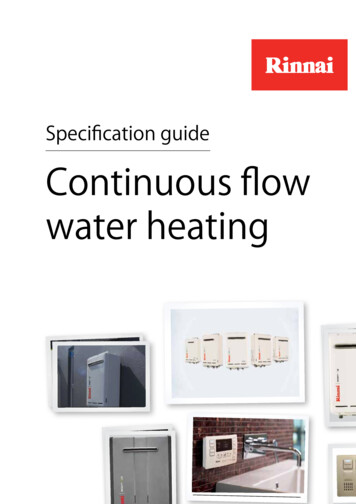
Transcription
Specification guideContinuous flowwater heating
ImportantThis guide has been written to help you select andorder the right Rinnai continuous flow water heater,associated components, and accessories for the rightjob. This information is not intended as an installationguide.Rinnai is constantly improving its products, and assuch, information and specifications are subject tochange or variation without notice. For the mostup-to-date information go to www.rinnai.co.nz.We’d love to hear from youIf you have any feedbackabout this guide we’d love tohear from you. Either emailus (place ‘Rinnai SpecificationGuide feedback' in the subjectheading), or call CustomerServices.For more information about buying, using, andservicing of Rinnai appliances call: 0800 RINNAI(0800 746 624)Rinnai New Zealand Limited105 Pavilion Drive, Mangere, AucklandPO Box 53177, Auckland Airport, Auckland 2150Phone: (09) 257 3800, Fax: (09) 257 3899Email: info@rinnai.co.nzWeb: www.rinnai.co.nz, www.youtube.com/rinnainzwww.rinnaitraining.co.nz (installer training)
:stnetncoLeaders in continuous flow.4What is continuous flow?.5Continuous flow summary table.6Model selection - domestic applications.7Product selector - domestic applications.8Rinnai Infinity digital water controllers.9Specifying commercial solutions.10Designing central water heating systems.11Manifold electronic control system (MECS).13Circulating ring mains with Rinnai Infinities.14Positioning continuous flow units.15General flue clearances - external models.16Rinnai Infinity VT specification summary.18Rinnai Infinity VT dimensions.19Rinnai Infinity VT accessories summary.20Rinnai Infinity VT service & maintenance.21Rinnai Infinity HD specification summary.22Rinnai Infinity HD dimensions.23Rinnai Infinity HD accessories summary.24Rinnai Infinity HD service & maintenance.25Rinnai Infinity EF specification summary.26Rinnai Infinity EF dimensions.27Rinnai Infinity EF accessories summary.28Rinnai Infinity EF service & maintenance.29Rinnai Infinity internal flueing.30Rinnai Infinity internal flueing options.31Rinnai Infinity internal flue configurations.32Rinnai Infinity internal flueing components.34Rinnai Infinity water controllers.36Rinnai Infinity composite recess box.38Rinnai Infinity metal recess box.39Rinnai Infinity pipe covers.40Rinnai Infinity security bracket.41Rinnai Infinity sideways flue diverter.42Rinnai Infinity upwards flue diverter.43Rinnai Infinity HD error switch.44Rinnai Infinity EZ connect cable.45Rinnai Infinity manifolding.46AppendicesAppendix 1: Limited warranty.48Appendix 2: Water flow and gas usage.51Appendix 3: Commercial sizing guidelines.57Appendix 4: LPG gas bottle consumption.58Appendix 5: Gas boosted solar.59
Leaders in continuous flowWhen you turn on a tap, you want water at the right temperature fast. Which is why, overthe years, we’ve devoted considerable time and resource to leading edge research anddevelopment.We were the first to introduce continuous flow technology, and have been tirelessly working on improving thisever since. Our commitment to bring you the latest in technology has resulted in the next generation of waterheaters.Original MicroProcessorQ-FunctionDynamic FlowControlV-SeriesRapid StartInfinity XRRinnai EfficiencyRinnai VTRinnai VTSeries-2*19911995200220042006200820112013The Rinnai Infinity range is made up of the following three categories.--Rinnai Infinity VT (domestic applications)Valve technology that delivers performance and efficiency for daily living.--Rinnai Infinity EF (domestic and commercial applications)High efficiency condensing technology to deliver further savings.--Rinnai Infinity HD (domestic and commercial applications)Heavy duty on demand for demanding jobs.* Rinnai VT Series-2: Improved software which allows the units to run more efficiently—this has resulted in increased energy star ratings.4 Rinnai Continuous Flow Water Heating Specification Guide 02-13
What is continuous flow?It is exactly that—a continuous flow hot water system. Unlike storage tanks that can runout, continuous flow units deliver a pre-determined flow rate every minute for as long asthe unit is running.General principle of operationEach Rinnai continuous flow water heater has a number of components thatcontrol the accuracy of the water temperature and the water flow:------PCB (the on-board computer)water control valvewater flow sensormodulating gas valveoutlet water temperature sensorPCBThe unit senses the need to start when the water begins to flow through theappliance (when a tap is turned on). The combustion fan starts, ignition begins(electronic requiring electricity), and the gas valve opens. Once the flame isestablished the appliance will heat the water as required until the tap is turnedoff.HCCGasThe difference between Rinnai Infinity VT/HD and Rinnai EFA Rinnai EF uses two heat exchangers to create continuous hot wateron demand, the Rinnai Infinity VT/HD has only one.How the Rinnai EF operates:1. Water travels to the secondary latent heat exchanger first.2. Combustion gases condense outside the latent heat exchangerand heat is transferred to the cold water. The water temperatureincreases by approximately 5 C.3.Water flows to the primary heat exchanger.Rinnai Continuous Flow Water Heating Specification Guide 02-13 5
Continuous flow summary tableModelMountingpositionApplication suitabilityEnergyInputstar ratingOutputThermaleff. onhighStatusmonitorInfinity VT16ExternalDomestic6.2125 MJ/h or 35 kW29.6 kW81%NoInfinity VT20ExternalDomestic5.9160 MJ/h or 44 kW34.9 kW80%NoInfinity VT24ExternalDomestic5.8188 MJ/h or 52 kW42.1 kW80%NoInfinity VT26ExternalDomestic5.8199 MJ/h or 55 kW44.2 kW80%NoInfinity HD200ExternalDomestic and commercial 5.9199 MJ/h or 55 kW47.0 kW82%YesInfinity HDi200InternalDomestic and commercial 6.1195 MJ/h or 54 kW45.1 kW83%NoInfinity HD250ExternalDomestic and commercial 5.6249 MJ/h or 69 kW59.9 kW81%NoInfinity EF24ExternalDomestic and commercial 6.8162 MJ/h or 45 kW43.0 kW95%NoInfinity EF250ExternalDomestic and commercial 6.8211 MJ/h or 58.6 kW55.6 kW95%YesInfinity EFi250InternalDomestic and commercial 6.8211 MJ/h or 58.6 kW55.6 kW95%YesWater delivery at a25 C rise16 L20 LE x te r na l mo d e l sHighefficiencyStandardefficiencyI n te r na l m o d e l sHighefficiencyStandardefficiency6 Rinnai Continuous Flow Water Heating Specification Guide 02-1324 L26 L32 L
Model selection - domestic applicationsWhen specifying residential hot water applications there are some basic questions thatyou need to ask in order to correctly design a system. You also need to bear in mindfuture requirements of the building. The key point is water heating solutions should bedesigned to the number of outlets and not people.How many bathrooms?A single bathroom home willoperate using the smaller InfinityVT16 or VT20 unit, whereas a twoor three bathroom home will mostlikely require the larger InfinityVT26, HD200, HD250, or EF250model.Type of shower roses installed?Typical flow rates for showers isaround 8-10 L/min, however thereis a large range of tapware on themarket with higher flow rates.This needs to be factored whendetermining the Infinity modelrequired.Design of the house?Where are the bathrooms andother wet areas in relation to thehot water system? The furtheraway the shower, the longer it willtake to get hot water. Typically ifan outlet is 15 m or greater youcould be looking at a time delay forhot water of approximately 10-15seconds. In most cases it is betterto site the Rinnai Infinity closer tothe kitchen sink where there is animmediate demand for hot water.To measure the flow rate of yourshower, hold a bucket under theshower rose for one minute andmeasure the volume.If bathrooms are situated atopposite ends of the house,two Rinnai Infinity units may berequired.How many people live in thehouse?The number of people living in thehouse also needs to be considered.As an example, you may havea two bathroom home, with acouple who rarely use the secondshower—an Infinity VT20 wouldeasily suffice. Similarly, the samehome could have Mum & Dad, andthree teenagers all fighting for twoshowers in the morning meaninga larger model Infinity would berequired.Geographical location in NewZealand?Ambient water temperatures willvary throughout the country, i.e.South Island during winter will tendto be much colder than the NorthIsland. This is important whendetermining the incoming watertemperature and temperaturedegree rise that is required as thisaffects the output of the unit. Referto the New Zealand map below.Positioning of the Infinity unit?Siting of Rinnai Infinity units aresubject to installation clearanceswhich may affect positioning. MostRinnai Infinity units are positionedexternally with a range of optionsfor fixture to the outside of thehouse, i.e. pipe cover so pipes canbe covered, unit can be securedfrom theft with a security bracket,or the unit can be recessed orpartially recessed so as to behidden from view. There arehowever some instances whereinternal units are more beneficial,this application requires flueingand is subject to some restrictions.*RADIUSWarmMildCoolRinnai Continuous Flow Water Heating Specification Guide 02-13 7
Product selector - domestic applicationsYour budget, size of house, number of outlets, and hot water requirements all factor indetermining the right continuous flow hot water system for your home. Use the productselector below to work out which model is right for you.1.Determine the hot water outlets that will run simultaneously in your house, and list the flow rates againstthem.Hot wateroutletTypical flow rate*Worked exampleBathroom10 L per minute10 LBathroom two10 L per minuteKitchen8 L per minuteLaundry8 L per minuteOtherAllow 8 L per minuteYour workings8LTOTAL18 L* You can check your own actual water flow rates by holding a bucket under the hot water outlet for a minute and measuring thevolume2. Total the maximum simultaneous water flow, e.g. 18 litres.3. In the column for geographical region move down until a number bigger than your total appears.Warm (L/min)Mild (L/min)Cool (L/min)VT modelHD modelEF 002503026222502503227232502504. Read across to the model, e.g. for 18 litres per minute in the mild zone a VT24 is selected.8 Rinnai Continuous Flow Water Heating Specification Guide 02-13
Rinnai Infinity digital water controllersWith a Rinnai Infinity digital controller, you choose your own personalised settings. Justselect the water temperature you want (37-55 C) in up to four different locations. Thismeans you can set water at a safe temperature in the bathroom (a great safety feature),then set it higher, if you wish, in the kitchen and laundry.To experience all the benefits of continuous flow hot water systems, Rinnai strongly recommend installing watercontrollers with all models (except those in solar or Rinnai iHeat installations). Rinnai’s controllers enable youto set your desired temperature, turn on the tap and enjoy—no more juggling hot and cold taps. Each remotecontroller can be individually programmed, however the water heater can only deliver one set temperature at anyone time.Temperature fluctuationsContinuous flow water heaters, like all types of water heaters, can experience temperature fluctuations whenother taps are turned on. Water controllers reduce fluctuations even when other taps are used, or a toilet isflushed.Extended warrantyRinnai Infinity installations with water controllers receive an extended warranty, refer to p. 48.Bathroom DeluxeKitchen DeluxeCompactWirelessController combinationsA maximum of four controllers can be fitted to a Rinnai Infinity, and any combination of the deluxe, compact, andwireless can be used with the following limitations:-- only ONE master controller can be installed, this can be a Kitchen Deluxe, Compact, or Wireless Controller-- up to TWO Bathroom Deluxe controllers can be installed-- The FOURTH controller in any installation must be a Compact or Wireless ControllerSolar, and Rinnai iHeat installations - controllers are not suitableRinnai water controllers cannot be used with Rinnai Infinity units connected to solar systems, or when a RinnaiiHeat is installed, as the preset DIP switch setting on the Rinnai Infinity is adjusted from 55 C to 75 C.Rinnai Continuous Flow Water Heating Specification Guide 02-13 9
Specifying commercial solutionsRinnai Infinity HD/EF units, manifolded units ( joined together), Demand Direct, DemandDuo, and Demand Rapid can provide all the hot water for large demand applications suchas sports clubs, restaurants, motels, and apartment projects.For full details on Rinnai’s Demandsolutions, please refer to theCommercial Water Heatingcatalogue available on our .Considerations when specifyingcommercial solutions-- Requirement for endless hotwater or demand over a shortperiod-- Water pressure and flowrequirements-- Capital cost limitations-- Running costs-- Positioning of units (external/internal)-- Flueing options-- Gas supply and availability-- Space restrictions for sitingunitsFor standard commercialapplications there are two typesof methods that can be used fordetermining a hot water solution.--Continuous flowProvides hot water endlessly ata constant temperature up to amaximum flow rate.--Average demandProvides an unlimited flowrate, but there is a limit tothe total volume of hot water(litres) that can be deliveredover a time period, i.e. onehour.Continuous flowThis application is used when thedemand involves all of the draw offpoints connected, usually at thesame time. Typical applications are:-- Restaurants-- Car washes-- Laundries-- Food processing plants-- Caravan parks-- Correctional facilitiesThe demand can be easilycalculated by totalling the fullflow from all the outlets used. Forexample, eight showers at 12 litresper minute equals 96 litres perminute.Average peak hour demandThis method applies when the useof draw off points occur as purelyrandom events over the demandperiod. Typical applications are:-- Apartments-- Hostels-- Hospitals-- Retirements villages-- Hotels and motelsThe demand for hot water isdependent on the following:-- Occupancy classification ofthe building--Number and type of hot wateroutlets--Number of personsaccommodated--Time of dayDue to the diversity of hot wateruse in these applications the useof Rinnai Infinity units coupledwith secondary storage may berequired to meet peak demand.Electronically manifolded unitswith primary flow and secondaryhot water return pipe work couldalso be viable.Continuous flow worked exampleA sporting facility change room has ten showers and six basins. The showers have shower roses with a flow capacity of12 L/min, and the showering temperature is assumed to be 42 C. The use of the basins is intermittent so they are notincluded in the calculation. The incoming water temperature is 15 C.1. Calculate the maximum simultaneous demand.10 showers x 12 L/min 120 L/min of mixed water at 42 C2. Calculate the hot water demand for the shower heads based on a mixed flow rate, using the calculation below.Hot water demand (shower flow rate) x (cold water temperature rise to mixed)(temperature rise from inlet to Infinity outlet temperature)120 x (42-15) 92.6 L/min (1.543 L/sec)50-153. Calculate the heating capacity required.1.543 L/sec x 4.2 (kJ/kg energy required to heat 1 kg of water 1 C) x (50-15) 226.8 kW is requiredFive Rinnai Infinity HD200 units, with an output of 47 kW each, could be manifolded together to meet this application.10 Rinnai Continuous Flow Water Heating Specification Guide 02-13
Designing central water heating systemsPerformance of Rinnai continuous flow units are directly related to hours of use and howwell they are maintained.It is important when designingcentral water heating systems thatthey are sized correctly. This willextend the life of the system andreduce ongoing maintenance andservicing costs.Design principles1. The Rinnai system should beregarded as a continuous flowsystem with storage back-up.Peak hour hot water demandestimationIn the absence of otherinformation, the followingcan be used to estimate peakhour demand. This method ofestimation has proven adequate inthe past, however Rinnai acceptsno liability in respect of thisestimate.capacity they will reduce the flowvia an internal water flow valveto maintain the set temperature.For this reason installing a largerpump will not increase systemperformance, and pumps may bedamaged due to cavitation whenoperating at reduced flows.RinnaimodelFlow per RinnaiHD/EF waterheater installedHeadrequired,add pipeallowance2. There should be sufficientRinnai HD/EF water heatersinstalled to supply peak hourdemand.Water use per person in peak hourat 60 C:-- 4-5 star hotel type accomm. 45 litresHD2000.3 L/sec8mHD2500.4 L/sec13 m3.--3 star accomm. 30 litresEF2500.4 L/sec11 m--Apartment buildings 25 litresPump timerAs a safety feature Rinnai waterheaters will only allow threeignition attempts before lockingout. In order to reset the waterheater and allow further ignitionattempts, water flow must stop. Ifignition has not occurred and thepump does not stop the water willremain cold. Fitting a timer to thepump power supply to periodicallyshut down the pump for a fewseconds will allow the water heaterto reset.Sufficient storage should beincorporated in the waterheating system to meet anyfluctuations in demand abovepeak hour average flow. Ingeneral 20% storage back-uphas proven to be sufficientstorage in most applications.4. Only Rinnai HD/EF modelsare warranted for commercialuse. In Rinnai’s currentcommercial range, the RinnaiHD200 units usually offer amore economical solution.The HD250/EF250 units arenormally used in smallerinstallations where theirsize provides a better flowmatch, or where space may berestricted.Adjustments should be madeas required for factors that areknown; high flow shower heads orother fixtures, spa baths, or loadpatterns where large numbers ofguests arrive or leave at the sametime (tour groups). Figures forother applications are providedin Appendix 3: Commercial sizingguidelines (p. 57).Pump sizingRinnai water heaters aredesigned to maintain outletwater temperatures at all times.If the flow exceeds their heatingSizing exampleA four star hotel in Wellington has fifty rooms with an average occupancy of 1.4 people per room.Peak hour estimate calculation45 litres per person x 50 rooms x 1.4 persons per room 3150 litres per peak hour at 60 CWith an incoming mid-winter water temperature of 10 C, a Rinnai HD200 will deliver 810 litres per hour at 60 C. Referto the water flow and gas usage tables at the back of this guide for additional delivery rates for each Infinity model.3150 810 3.9 units 4 x Rinnai Infinity HD200’s would be required.Storage backup20% of peak hour requirement: 3150 x 0.20 630 litres of storage backup required.Rinnai Continuous Flow Water Heating Specification Guide 02-13 11
Fault indicationIn multiple unit installations it is important to know if a water heater is faulting. If a water heater is faulting thisincreases the wear and tear on the water heaters and will cause progressive reduction in the hot water supply ifmore units fail.Rinnai HD/EF water heaters can be fitted with a Rinnai HD Error Indication Switch (part R1070), volt free contact,which will close to indicate a water heater is not operating. This can be connected to a building management orother system to give a signal to call a service person.MaintenanceRinnai recommends annual maintenance. Maintenance can be easily accomplished as individual waterheaters can be isolated from the system without significantly affecting the hot water supply.Standard system setup in a central water heating systemSet point 75 deg.Set point 75 deg.Set point 75 deg.Set point 75 deg.ThermostatOn 60 ºCOff 65 ºCChecklist Rinnai HD/EF models installed Rinnai water heaters are set to 75 C Tank thermostat OFF and set to no more than 65 C 'Y' strainer in front of circulating pump—do not rely on strainers in Rinnai water heaters Isolating valves fitted to hot and cold connections on each Rinnai water heater (allows water heaters to beindividually isolated for routine maintenance) Flow and return manifolds to Rinnai water heaters balanced—starting from the cylinder. The total length ofpipe to a water heater and back to the cylinder should be the same for each water heater. Electronic manifolding is not installed on Rinnai water heaters Timer fitted to pump power circuit (e.g. 15 minutes ON, 30 seconds OFF)12 Rinnai Continuous Flow Water Heating Specification Guide 02-13
Manifold electronic control system (MECS)Infinity units can be manifolded together (up to 25) by connecting them in parallel toenable a greater hot water flow rate than is possible with a single unit. MECS is a totallyintegrated system, unique to Rinnai, that links each Infinity unit in the system and will turnon each unit as required. The system is designed to ensure gas is not wasted and that anendless supply of hot water is always available.How it worksA master and sub-communication PCB is installed in the first unit and other subsequent units have only the subcommunication PCB (slave cable) installed. The master communication PCB receives information about flow ratesfrom the PCB of each unit and balances the load on each unit.All information is transmitted via communication cables to the slave units. The master control also has an inbuiltfault detection system and will allocate a replacement unit should one fail.Typical manifold setupREUMSBMBMC91(MECS masterslave kit)(Compactcontroller)Up to 25GasHotdeliveryColdSupplyOn electronically manifolded systems keep the hot water outlet connections to the common manifold as short as possible to avoidcold slugs. Also keep the water heaters as close together as possible.If you think a Rinnai Infinity manifolded solution is right for you, please contact Rinnai Customer Services and theywill advise what components you will need.Rinnai Continuous Flow Water Heating Specification Guide 02-13 13
Circulating ring mains with Rinnai InfinitiesHot water immediately when you turn on the tap—circulating ring mains give hot waterinstantly at all outlets.High temperature circulating ring mainNotes on circulating systems withInfinity water heatersREUMSBMB(MECS masterslave kit)Cylinder volume should be 10 xthe pipe volume between the Rinnaiwater heater and cylinder.Temper outlets as required withpoint-of-use tempering valves.GASColdSupplyBuilding FlowTo DrainElectric cylinderSet point 65 ºCTo minimise running costs thecirculating pump can be controlledby a timer to ensure it only runsduring hours of normal water use. Thepump can be further controlled by athermostat to turn off the pump oncethe water in the ring main is up totemperature.Pumps for domestic and small commercial systemsGrundfos UP 15-14B15 mmGrundfos UP 20-14BX20 mmPump accessoriesThermostatTimerTimer & thermostatAdd suffix ‘T’ to codeAdd suffix ‘U’ to codeAdd suffix ‘UT’ to codeExpansiontankBuilding returnLow temperature circulating ring mainUnit 1Unit 2Unit 3Unit 4Unit 5Low temperature ring mains arebecoming popular as an economicand reliable solution for largerinstallations.Reduce installation and maintenancecosts by eliminating tempering valvesat each outlet. 55 CUV Steriliser 60 CColdinletGas14 Rinnai Continuous Flow Water Heating Specification Guide 02-13
Positioning continuous flow unitsIn order to provide safe and effective water heating it is important to adhere to allrelevant gas installation standards. Prior to purchasing or siting an appliance check theguidelines detailed in this section.Internal modelsInternal models aredesigned for indoorinstallations only.They may be installedin an enclosure if therequirements ofAS/NZS 5601.1 are satisfied.An enclosure is defined as acompartment, enclosed area orpartitioned off space primarilyused for the installation of theappliance.They must be mounted on avertical structure with the waterand gas connections on theunderside pointing downwards.External modelsExternal models aredesigned for outdoorinstallations only. Theymust be located in anabove ground open-airsituation with naturalventilation, without stagnantareas, and where gas leakage andproducts of combustion are rapidlydispersed by wind and naturalconvection.They must be mounted on avertical structure with water andgas connections on the undersidepointing downwards. Rinnairecommend a clearance from theground of 1.5 m to give enoughclearance for the pipe work, and tosafely expel flue gases. This differsto the AS/NZS 5601.1 of 300 mm.Multiple external unitsWhen multiple units of thesame model are installed on thesame vertical face, with the flueterminals at the same height, theycan be installed next to each otheras shown.Easy access to unitsAll continuous flow water heatersmust be installed to ensure accesscan be gained, for servicing andrepair, without hazard or unduedifficulty. Sufficient clearances shallallow access and removal of allserviceable components.For internal units we recommenda 600 mm clearance for servicingaccess. This can be reduced to50 mm if installed in a cupboard.All modelsThe appliance must be placedas close as possible to the mostfrequently used hot water outletor outlets to minimise the delay forhot water.For installations where the distancebetween the water heater andthe outlets is considerable, aflow and return system can beused to minimise the waitingtime for hot water delivery.Alternatively, multiple appliancescan be strategically placed to servedifferent outlets.Electrical supplyAn AC 230 V, 10 Amp earthedpower point must be providedadjacent to the appliance. Foroutdoor installations, this powerpoint must be weatherproof. Itmust be clear of the gas and waterconnections to the appliance andalso the flue exhaust and waterpressure relief valve. The powercord of continuous flow units is1.5 m.75 mmmin.75 mmmin.600 mm min.(50 mm min if in a cupboard)Appliances should not be mountedhigher than 3.5 m above theground or floor level unless thecustomer can arrange permanentand safe access, or can provideanother means of access such asscissor or boom lifts.Noise considerationSome people are susceptible tolow level noise. Rinnai Infinity unitsoperate at approximately49 dB(A). This needs to beconsidered if siting the appliancenear a bedroom.Clearances required for flueterminalsAll Rinnai continuous flow waterheaters must be located so thatthe flue terminal exits the buildingat a suitable point—refer AS/NZS5601.1 Fig 6.2. A diagram to assistin determining where, and if, anexternal model can be installed isshown on the next page.Rinnai Continuous Flow Water Heating Specification Guide 02-13 15
General flue clearances - external modelsThe following diagram has been provided to assist in determining where, and if anexternal continuous flow water heater can be installed. If in doubt, consult a licensedgasfitter who will have access to 'Minimum clearances required for balanced flueterminals, fan-assisted flue terminals, room-sealed appliance terminals and openings ofoutdoor appliances' from AS/NZS 5601.1 (p. 94-95).GDim.Infinity VT, HD200,EF modelsInfinity HD250modelsAMin. 300 mmMin. 500 mmBMin. 300 mmMin. 500 mmCMin. 1.5 mMin. 1.5 mDMin. 500 mmMin. 500 mmEMin. 300 mmMin. 300 mmFMin. 300 mm*Min. 300 mm*GMin. 300 mmMin. 300 mmClearance below eaves, balconies, and otherprojections for all models is 300 mm.* Rinnai recommend 1.5 m to give enough clearancefor the pipe work, and to safely expel flue gases.16 Rinnai Continuous Flow Water Heating Specification Guide 02-13
Rinnai continuous flow water heatersProductspecificationpages
Rinnai Infinity VT specification summaryRinnai Infinity VT external codesGas Continuous flow gas hot water heaters (with inbuilt frost protection), preset to 55 C, for external domesticapplications. Suitable for mains and low pressure systems. Electronic ignition—requires electricity to operate.Infinity VT (Valve Technology) uses a new manifold system, which at lower flow rates, precisely matches watersupply to flow demand at the required temperature.Hard or acidic water will need to be treated to use this product.Specification summaryVT20VT24VT26REU eWhiteWhiteHotR½ (15 mm)R¾ (20 mm)R¾ (20 mm)R¾ (20 mm)ColdR½ (15 mm)R¾ (20 mm)R¾ (20 mm)R¾ (20 mm)GasR¾ (20 mm)R¾ (20 mm)R¾ (20 mm)R¾ (20 mm)Efficiency81%80%80%80%Energy star rating6.2 star energyequivalent5.9 star energyequivalent5.8 star energyequivalent5.8 star energyequivalentHot water capacity1.5-16 L/min1.8-20 L/min1.8-24 L/min1.8-26 L/minNominal watercapacity*16 L/min960 L/h20 L/min1200 L/h24 L/min1440 L/h26 L/min1560 L/hInput on max.125 MJ/h160 MJ/h188 MJ/h199 MJ/hOutput on max
us (place 'Rinnai Specification Guide feedback' in the subject heading), or call Customer Services. Important For more information about buying, using, and servicing of Rinnai appliances call: 0800 RINNAI (0800 746 624) Rinnai New Zealand Limited 105 Pavilion Drive, Mangere, Auckland PO Box 53177, Auckland Airport, Auckland 2150

